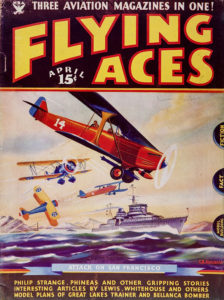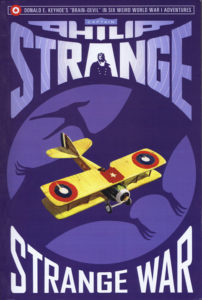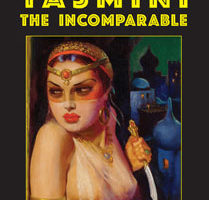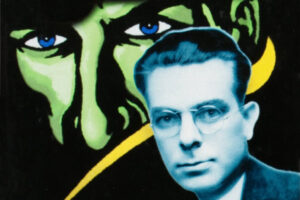 Flying Aces, published by Ace Magazines/Periodical House, is one of the rare pulp magazines that continued past the pulp era, by evolving beyond being a pulp magazine.
Flying Aces, published by Ace Magazines/Periodical House, is one of the rare pulp magazines that continued past the pulp era, by evolving beyond being a pulp magazine.
Launched in 1928, it was your typical air adventure pulp magazine, with stories contributed by many writing in that area: Archie Whitehouse, Joe Archibald, Donald Keyhoe, Robert Sidney Bowen, Major George Fielding Eliot, and others. In the early years, most stories were stand-alone, with only the rare serialized characters. Later the magazine had a lot of serialized characters.
A major change in the magazine occurred in 1933. It went from being published on pulp paper to slick paper, and added plans for model planes as well as non-fiction articles, to make it more appealing to a wider range of airplane enthusiasts. They even plugged it as being “3 magazines in one”!
The next major change happened in 1943. The fiction were dropped! It would be solely non-fiction work and aviation modeling. Over time the aviation modeling took precedence, and the magazine was renamed Flying Models in 1947 and sold to Carstens Publications in 1969, which published other magazines in the model train and airplane hobbies. The magazine ceased publishing in 2014 when the company went under.
Now, as I noted, there were several serialized characters in the magazine, most in the later period. A few of these are now being reprinted by a couple of publishers. These are the ones I know of.
• Phineas Pinkham was created by Joe Archibald. Phineas was a WWI pilot fighting in France. He is described as a poor pilot who downed enemy pilots more by trickery and luck than piloting skills. And from what I can gather, these were more humorous stories. He ran for 12 years, from about 1931 to 1943, and outlasted all the other fiction series with almost 150 stories! Archibald put out a reprint book of stories in 1974, and someone else has done this on their own and made the book available on Lulu.
• Capt. Philip Strange was created by Donald Keyhoe, one of several serial characters he created for Flying Aces. A pilot and spy set in WWI, he was known as “the Brain Devil” and “the Phantom Ace of G.2,” and had ESP and other mental powers. His stories were not your run-of-the-mill WWI stories, but had him deal with bizarre enemies and threats. He is thought to be an inspiration to G-8. His series ran for nine years, 1931–39 and 64 stories. Age of Aces is reprinting his stories and have put out five collections so far.
• Hell-Cats by Alexis Rossoff started in War Birds (published by Dell) in 1928, continued into Flying Aces from about 1931 to 1935, then moved to Wings (published by Fiction House) until 1946, for a total of 19 stories. A group of Allied fliers in WWI, they are melancholy over the lost of comrades.
 • Battling Grogan by Robert Burtt ran for 14 stories from 1932-34. Set in pre-WWII China, it stared Grogan, an American pilot leading a squadron of Chinese pilots. Age of Aces has reprinted the entire series in one volume.
• Battling Grogan by Robert Burtt ran for 14 stories from 1932-34. Set in pre-WWII China, it stared Grogan, an American pilot leading a squadron of Chinese pilots. Age of Aces has reprinted the entire series in one volume.
• The Griffon, created by Arch Whitehouse (one of several series he did), is really Kerry Keene a U.S. Department of Justice employee. A contemporary series, it has layabout millionaire Keene going into action as the masked Griffon in his supercharged seaplane to fight injustice. He is aided by his tailgunner Barney O’Dare. Forty-three stories were published between 1935 and 1942. Altus Press is doing a reprint series (three volumes so far), with Pro Se Press doing new stories.
• Richard Knight was another Donald Keyhoe creation. Another “superhuman” pulp hero, Knight was blinded in WWI, but gained the ability to see in the dark! His adventures were contemporary, but included bizarre lost world stories. His series ran from 1936–42, for 35 stories. Altus Press is doing a reprint series (two so far), with Pro Se Press doing new stories.
• Coffin Kirk by Whitehouse is a pretty bizarre series. Brian Kick watched his zoo-keeper father murdered by a German spy ring. After years of planning and training to go up against the “Circle of Death,” he finds the group is now allied with the Axis powers. So Kirk goes after them aided by his tail-gunner Tank, a trained gorilla who can talk, load guns, and repair aircraft! This series had six stories that ran from 1937 to ’41. Age of Aces put out one volume of stories as a Pulpfest special, which has the whole series.
• Buzz Bensen by Whitehouse stared in Sky Birds from 1930 to 1935, when the magazine shut down and the character moved to Flying Aces and lasted there until 1937 or so for 72 stories. A Secret Service agent who works as a reporter, he travels and gathers information for the Service. And also gets involved in stopping crime rings, or the Japanese (or analogues) who are trying to destroy the U.S.
• Tug Hardwick by Whitehouse was a short-lived character with eight stories between 1937 and 1941. A former WWI pilot who had stopped flying and became a correspondent, Hardwick resumes flying after the events in Shanghai. Now he fights (and flies) for the Chinese and White Russians against the Japanese. Maybe Age of Aces could reprint this one?
• Crash Carringer also by Whitehouse ran for 11 stories from 1938 to 1941. Carringer is a salesman for an aircraft company, which has him flying around the world to sell to individuals and governments. He gets into adventures in places like China, Afghanistan, and the Middle East against various groups like warlords and Japanese invaders.
• Eric Trent was Keyhoe’s final serial character. Short-lived (13 stories from 1940-42), it follows Trent was an American who gets involved in Nazi plots and threats just before the U.S. entered WWII, and a little after. He is not a formal agent, but more freelance. Altus is reprinting the whole series in two volumes, the first one out.
Information on all the series characters in Flying Aces is hard to track down, so am sure I left out some series.
For some of these characters, I plan to do separate postings with more information. As noted, a few (very few) are being reprinted. If people want to see more of these reprinted, purchase the existing collections and reach out to Age of Aces and Altus Press, as the main publishers working this area, and let them know you are interested in reading these adventures.



